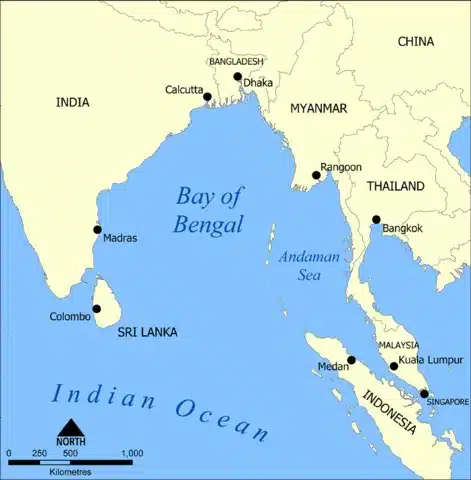The Bay of Bengal, a vast body of water nestled between the Indian subcontinent and Southeast Asia, has long been an arena of strategic significance in the geopolitical landscape. Its geographical location and rich natural resources have bestowed it with immense importance, attracting the attention of various nations vying for influence, economic gains, and security in the region. In this article, we delve into the geopolitical significance of the Bay of Bengal and explore how it shapes the dynamics among nations.
Geographical Location
The Bay of Bengal, spanning a vast expanse of 2.17 million sq-km, is the world’s largest bay. Positioned as the central bay within the expansive “Great Middle Bay” of the Indian Ocean, it occupies a pivotal role in the region’s geography. The Bay of Bengal countries have a population of 1.7 billion and a GDP of USD 7 trillion.
Geopolitically, the Bay of Bengal is surrounded by key nations on its western and northwest shores, including India, while Bangladesh borders it to the north. To the east, Myanmar and the Andaman and Nicobar Islands of India define its boundaries. The southern limit is marked by an imaginary line stretching between Sangaman Kanda in Sri Lanka and the northeasternmost point of Sumatra, Indonesia.
Maritime Trade
The Bay of Bengal serves as a crucial maritime trade route. It connects the Middle East, Africa, and Europe to the economies of Southeast Asia and East Asia. The Malacca Strait, one of the busiest shipping lanes globally, links the Bay of Bengal to the South China Sea, making it an essential passage for commercial vessels carrying goods and resources. Roughly half of the globe’s container traffic traverses through this area, with its ports efficiently managing approximately one-third of the world’s trade volume. The countries bordering the bay, such as India, Bangladesh, Myanmar, Thailand, and Sri Lanka, have a strategic advantage due to their proximity to these trade routes, enhancing their economic potential.
Energy Resources and Energy Security
The Bay of Bengal holds significant hydrocarbon reserves, making it an attractive prospect for energy-hungry nations. Offshore oil and gas exploration have increased in recent years, with India and Myanmar being major players in the region. India and China are both vying for access to Myanmar’s offshore gas fields.
The abundance of natural gas and oil resources also presents an opportunity for energy cooperation and collaboration among the littoral states, promoting economic growth and regional stability.
Maritime Security and Piracy
The Bay of Bengal is not without its security challenges. The presence of piracy and maritime terrorism remains a concern, particularly in the northern part of the bay. Piracy incidents have disrupted shipping and trade routes, necessitating joint efforts among littoral states to combat piracy and ensure safe navigation in the region. Additionally, the bay’s maritime security is of interest to major powers seeking to protect their interests and maintain regional stability.
Military and Strategic Interests
Several major powers, including India, China, and the United States, have a vested interest in the Bay of Bengal due to its geopolitical importance. India, as the dominant regional power, seeks to maintain its influence and secure its maritime borders. On the other hand, China, with its ambitious Belt and Road Initiative, is keen on expanding its presence and influence in the region, particularly through port development projects in countries like Sri Lanka and Bangladesh. The United States also monitors developments in the Bay of Bengal to safeguard its interests and ensure regional stability.
Climate Change and Environmental Concerns
The Bay of Bengal is highly vulnerable to the impacts of climate change, including rising sea levels, cyclones, and extreme weather events. The delta regions of the Ganges, Brahmaputra, and Irrawaddy rivers are at risk of increased flooding and coastal erosion. Such environmental challenges can exacerbate existing geopolitical tensions, as they may lead to displacement of populations, resource competition, and disputes over adaptation and mitigation efforts.
Summary of ‘Geopolitical Importance of the Bay of Bengal’
The Bay of Bengal, with its strategic location, abundant natural resources, and significance as a maritime trade route, continues to play a crucial role in shaping geopolitical dynamics in the region. As countries seek to assert their interests and secure their borders, cooperation and diplomacy will be essential to ensuring stability and sustainable development in this vital area. Addressing common challenges, such as piracy, environmental degradation, and territorial disputes, through dialogue and collaboration will pave the way for a more prosperous and secure future for the nations bordering the bay.








